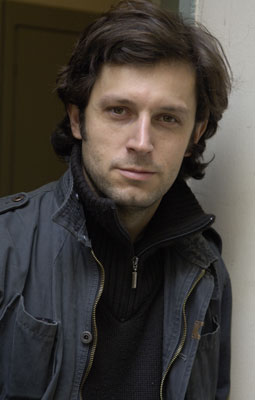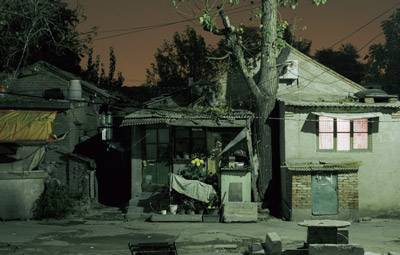
The memories of bungalows, roofed with grey tiles and shadowed
under elm trees, are fading away in Beijing, a city now crammed
with geometric apartment blocks and modern shopping malls. French
photographer Ambroise Tezenas' shots display a sequence of scenes:
a shared kitchen in a courtyard, several frozen pieces of clothing
hanging outdoor in frigid winter and dim public toilets along
narrow streets. Significantly, these ordinary images have been
blurred in the last few decades as the ancient city capital
experiences dramatic transformation. (Video: French photographer
Ambroise Tezenas wants to present the poetic side of
Beijing  )
)
Yet the photos taken by Tezenas while exploring Beijing's
remaining alleyways conjure up serene moments in Beijing's past:
birds chirping at dawn into tightly shut windows; faint summer
scents from blossoming Chinese scholar trees wafting over naughty
children climbing and brightly patterned cotton curtains veiling
mysterious indoor lives. Tezenas' work reflects these scenes,
subtly highlighting forgotten beauty, gracefully revealing charm.
Tezenas himself explained that his efforts are meant to depict an
"eternal Beijing".
|

Ambroise Tezenas
|
The French photographer has paid five visits to Beijing since
2001, when he learned that the ancient capital was elected to be
the host city of the Olympic Games in 2008. "Many changes are going
to take place in Beijing and I wanted to record that," he told
Beijing Today last December. Certainly, Tezenas chose an unusual
angle to document the changes before the upcoming Olympiad – all of
his photos on exhibit at the Paris-Beijing Photo Gallery in
Dashanzi 798 have uncovered ancient alleyways, gently
carpeting the city's serene nights inside an urban milieu.
His photographs capture unadulterated images: vegetables
scattered around a shabby storeroom, colored brightly behind a dark
backdrop of a bleak night; a grocery stand located under a massive
tree lies braced in light pink along a dark street, as a bicycle
leans against a patched brick wall. For even more dramatic effect
the viewer's eyes are drawn to a bunch of chrysanthemums grafted in
a flower pot in front of a modest bungalow built around a towering
tree – looking inside, a shaft of electric light penetrates pink
curtains stamped with the auspicious Chinese character "double
happiness", following tradition and indicating the home of a
newly-married couple.
"My aim was to get a feeling of the ancient city. We all have
feelings towards things, we like a color or find some curtains
interesting because we imagine life behind it," Tezenas said in an
exclusive email interview to China.org.cn. To avoid catching any
passer-bys in the frame, the photographer prolonged his exposure
times during night shots in the "Hutongs", describing his
experience as "a visit to a theater". "No reason to include faces
and modern signs when I'm trying to show an eternal Beijing," he
remarked.
The long exposure time and special lenses have made Tezenas'
photos resemble paintings; they are impressionistic. Shadows of
houses and trees frame the pictures. Spotlights illuminating
detailed life scenes from windows, gates, billboards, worn-out
sofas or construction scaffolds, are highlighted by colors applied
in natural layers on all ends of the spectrum – from emerald green
to dark blue, shades of gold to yellow, maroon to pink, white to
gray. "I greatly admire landscape photographers like Edward
Steichen (1879-1973). He chose to take pictures using artificial
effects to get a stronger feeling of things," Tezenas
commented.
 |
When Tezenas incorporated special techniques to depict a city
reflecting his emotions, some domestic viewers voiced diverse
reactions. "The color he adopted in the pictures does not make them
unique to Beijing; it brings to my mind other Hutongs around
China. But his images all create nostalgia for our Chinese
childhoods," remarked Wang Zhe, a 25-year-old woman from southern
China. "For me, Beijing appears stern because of the gray and black
Hutongs."
Tezenas believes that he has photographed an authentic facet of
the city without modifying it by using additional light. "I tried
to make the city mine, just by looking at it. When I was passing by
a greengrocer, I had no reason to beautify scattered vegetables; I
just felt that the scene under these light conditions was certainly
worth a try, it deserved a shot. Good pictures tell stories. By
taking pictures the photographer creates his own story; a viewer
might gaze at my photos and have another story in mind," Tezenas
said.
Recent years have witnessed a process of rapid modernization in
Beijing. No more than 220 days are left before the upcoming Olympic
Games. Transportation lines connect the urban and suburban parts of
the city into a whole; apartments, office buildings and shopping
malls are mushrooming; construction of the Olympic National Stadium
and the National Swimming Center, deemed the "Bird's Nest" and the
"Water Cube", have captured global attention.
Trying to understand authentic culture in Beijing, a city that
is now experiencing profound changes, inspired Tezenas read
prolifically before coming to this frenetically evolving oriental
world. "In a certain kind of way for me, as I walk around Beijing
by night, it's a bit like walking in Buenos Aries or London. First
and foremost it's me who's trying to see the world through my own
eyes. The photographer's psychotherapy, some would call it. Now, by
coming back to Beijing year after year, I have become closer and
closer to the city." He added that he would continue visiting
Beijing and discover more about China.
Dates: Dec.8--Jan.19
Venue: Paris-Beijing Photo Gallery
Address: Dashanzi 798, No.4 Jiuxianqiao Rd, Chaoyang District
(China.org.cn by staff reporter Wu Jin January 8, 2008)